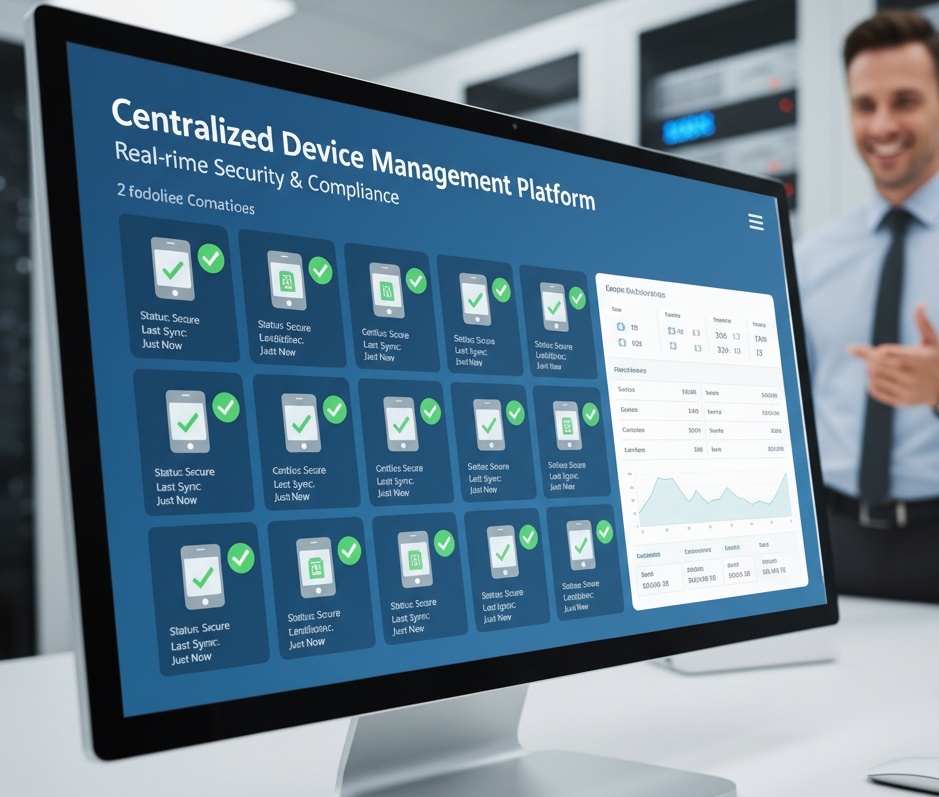The Top 5 Challenges of Manual Android Certificate Management
Certificates are key credentials for secure device access to corporate networks, Wi-Fi, VPNs, and applications. Their importance is self-evident. One study indicates that over 90% of enterprise mobile applications rely on certificates for security authentication. Despite this, many organizations continue to rely on manual management models that rely on manual operations.
While this model may appear to save on initial investment, it actually carries significant operational, security, and compliance risks. Data shows that enterprise IT teams spend an average of over 10 hours per week dealing with certificate-related issues, highlighting the efficiency bottlenecks inherent in the manual model.
This article will delve into the five core challenges of this manual management model, revealing its profound impact on businesses and providing crucial insights for strategic transformation.
Core Challenge Analysis: Five "Inherent Sins" of Manual Certificate Management
Although, manual certificate management might save you the initial cost, it is inherently prone to flaws and errors. Besides, in the long run, it isn't cost effective. Below are some the biggest challenges posed by manual certificate management.
1Challenge 1: High labor and time costs

Manual certificate management is inherently labor-intensive, costing IT staff not only salaries but also significant opportunity costs. As the number of devices increases, the manpower and time required to manage this work increases nonlinearly, ultimately becoming a significant operational liability.
Complicated configuration and deployment process
Under the manual model, IT teams must perform a series of repetitive and time-consuming operations for each Android device. The first step is certificate generation and importing. This involves generating a unique certificate for each device or user, distributing it via insecure methods like email, USB drives, or face-to-face instruction, and guiding users through manual installation and configuration.
It's estimated that manually configuring certificates for each device takes an average of 15 to 30 minutes. Furthermore, IT administrators must manually manage the certificate private key on each device, a task that is not only technically complex but also prone to human error.
The second step is matching devices to users. IT teams must create and maintain detailed spreadsheets or internal databases to accurately record which certificate is assigned to which user or device, especially in complex BYOD (bring your own device) or device sharing scenarios. In this hybrid work model, the complexity of certificate management increases by over 40%, making manual tracking nearly impossible.
Endless maintenance and support burden
The cost of manual management isn't a one-time expense. Certificates have validity periods, and when they're about to expire, IT teams rely on spreadsheets or calendar reminders for early warning and updates.
This approach is vulnerable because it's highly reliant on manual labor, making it easy for mistakes to be missed due to personnel changes or negligence, leading to certificate expiration. Research shows that 70% of certificate expiration incidents are due to a lack of automatic reminder mechanisms. Once a certificate expires, the device can no longer access corporate resources, generating a large number of IT support requests.
According to statistics, certificate-related issues account for more than 25% of support requests for mobile device failures in enterprises. This constant troubleshooting and user support not only consumes valuable IT team time, but also reduces the efficiency of terminal employees.
Typical scenario: "Overtime rush" when new equipment arrives
A retail chain planned to open five new stores within three days and needed to install Wi-Fi certificates for 200 self-checkout kiosks to ensure proper connectivity and payment processing on opening day. The three IT staff in charge worked tirelessly from morning till night, connecting and configuring each device individually, sometimes working overnight.
However, 15 devices remained undeployed due to issues like "driver incompatibility" and "certificate file corruption." On opening day, these 15 devices were unusable, resulting in long queues and some customers abandoning their purchases due to the long wait, resulting in a loss of nearly 10,000 yuan in revenue.
The costs associated with a manual management model aren't simply a matter of "time = money." They represent a "non-linearly growing operational liability."
For example, manually configuring certificates for 100 devices can take 25 to 50 hours, nearly a week's worth of work for an IT staff member. When we factor in unpredictable additional work like certificate renewals due to expiration, employee revocations, reconfiguration of lost devices, and troubleshooting due to configuration errors, we see that this continuous, reactive operations model prevents IT teams from focusing on more strategically valuable tasks, such as security policy upgrades or exploring new technologies. This is fundamentally unsustainable and represents a hidden barrier to enterprise digital transformation.
2Challenge 2: Difficult-to-prevent security risks

The defects of the manual management model in certificate lifecycle management have fundamentally created security vulnerabilities, and their impact far exceeds simple operational issues.
Security vulnerabilities caused by expired certificates
Expired certificates not only cause business interruptions but can also pose serious security risks. Once a certificate expires, the chain of trust between the device and the internal network or application is immediately broken, rendering critical services unavailable.
Statistics show that service interruptions caused by certificate expiration result in an average of several hours of business downtime. A further risk lies in the fact that failure to promptly update certificates can cause businesses to fail to meet strict industry compliance standards, exposing them to fines and legal risks.
Furthermore, if expired certificates are not promptly identified and revoked, some expired certificates can still be abused in specific scenarios, posing a potential threat of unauthorized access. Millions of certificates expire each year due to poor management, with some being exploited maliciously, highlighting the severity of this issue.
Risks of certificate leakage and abuse
Manual management limits control over certificates. When an employee's Android device is lost or stolen, the certificate cannot be immediately or remotely revoked. This allows attackers to gain access to sensitive internal corporate data through the certificate.
Surveys show that over 50% of companies lack robust certificate revocation processes to address device loss or theft, creating a significant management blind spot.
An even greater concern is the lack of certificate lifecycle management, especially when employees depart. Manually revoking all corporate certificates is difficult for IT teams to ensure timely and complete revocation.
Statistics show that it takes an average of three to five days for IT teams to manually revoke all certificates for a departing employee, creating a highly risky security window. This effectively leaves a backdoor for departing employees, posing a long-term security risk.
The fundamental flaw of the manual management model is its inability to achieve real-time and scalable control. This lag is fatal in the face of rapidly evolving cybersecurity threats. When certificates expire or devices are lost, IT teams are unaware immediately due to a lack of automated monitoring and alerting.
Even if they are aware, the manual revocation process can take days, creating a significant security window. During this window, expired certificates can be misused, and certificates on lost devices can be stolen, ultimately leading to data breaches, unauthorized access, and business disruptions.
This lag escalates a simple management issue into a systemic security vulnerability, potentially resulting in millions of dollars in losses and significant damage to brand reputation.
Typical scenario: "Business interruption" caused by certificate expiration
Case: The chain reaction caused by the expiration of tablet certificates of employees at a financial institution
A city commercial bank equipped 50 relationship managers with Android tablets for on-site loan processing. These tablets required VPN certificates to access the bank's head office system to check customer credit information.
One morning, all the relationship managers reported that their tablets were unable to connect to the VPN. After investigation, they discovered that the VPN certificates had expired and had not been renewed.
This was during peak loan application season, and the relationship managers were unable to check credit information and had to temporarily return customers. Some customers, due to the long wait, switched to other banks.
According to statistics, this outage caused the bank to lose nearly 20 loan applications that day, resulting in a direct revenue loss of over 500,000 yuan and a negative impact on customer trust.
Secure Your Enterprise with AirDroid Business
Worried about security risks from expired or leaked certificates? AirDroid Business provides comprehensive lifecycle management to protect your data and ensure compliance.
3Challenge 3: Bottlenecks in Scale Management

Manual management cannot effectively scale with the expansion of enterprise scale, becoming a bottleneck for enterprise growth. The operational and maintenance pressure of this model increases linearly, while the number of devices in an enterprise often increases exponentially.
Linearly growing operation and maintenance pressure
In a manual management model, each additional device adds a corresponding unit of workload to the IT team. This linear growth model is completely unworkable for large-scale deployments. When the number of devices in an enterprise exceeds 500, the workload of manual management increases exponentially.
According to industry data, each IT administrator in a large enterprise needs to manage an average of 200 to 300 mobile devices, placing enormous pressure on individual IT staff. With the rapid adoption of Internet of Things (IoT) devices and smart terminals, the number of devices in the future will far exceed that of traditional mobile devices, further exacerbating the bottlenecks of manual management.
Slowing Down the Business
The cumbersome manual certificate configuration process becomes a roadblock when onboarding new employees, launching new projects, or expanding businesses. This directly impacts an enterprise's ability to quickly respond to market demands. A comparative analysis shows that bringing new devices online under a manual model takes over three times longer than under an automated model, significantly slowing down business operations.
The underlying root cause of these scalability challenges lies in an overreliance on single points of failure and rigid processes. Manual models rely on a small number of IT staff and fixed processes. When the number of devices surges, these single points of failure become bottlenecks for the entire system.
When business departments need to quickly configure access rights for a large number of new employees or devices, the IT team becomes overwhelmed, configuration times prolong, and even errors increase due to frequent operations.
A seemingly minor technical management issue has escalated into a major bottleneck hindering a company's strategic development and market competitiveness, fully demonstrating that manual models are no longer adapted to the demands of the modern business environment.
Case Study: Manual Management Hinders Overseas Business Expansion for a Cross-Border E-Commerce Company
A cross-border e-commerce company was accustomed to inefficient manual certificate management. When they planned to add 200 new devices in Europe, this expansion campaign exposed the fatal weakness of manual management. Unable to deploy remotely, the IT team had to dispatch two employees to Europe, incurring travel expenses of 80,000 yuan and only managing to deploy 120 devices within 30 days.
This directly led to decreased efficiency in their overseas warehouses, a surge in order delays, and a 50,000 yuan fine for failing to meet platform timelines. More seriously, some devices faced regulatory warnings due to certificate configurations that did not meet European compliance standards, nearly jeopardizing their operational qualifications.
This failed expansion made the company realize that manual management was not only inefficient but also a significant obstacle to global business expansion, with certificate issues threatening to derail the entire expansion process at any time.
4Challenge 4: Error-prone manual operations

Under manual management, the potential for damage and chain reactions caused by human error cannot be ignored. This risk is not an isolated incident but a systemic one.
Common configuration errors
Common errors in manual operations include copy-paste errors, mismatched keys and certificates, and input errors. These seemingly minor mistakes can lead to serious consequences.
Studies have shown that the probability of manual operations leading to certificate configuration errors is as high as over 10%. These configuration errors are one of the main causes of mobile device network connection failures, directly affecting employees' daily work.
The chain reaction caused by the error
A simple configuration error can trigger a "domino effect." For example, an error in the certificate format or key input may prevent the device from connecting to Wi-Fi or VPN properly. The failure of this single device may trigger a series of chain reactions: employee work interruption, a surge in IT support requests, and even impact on data transmission or services that rely on the device.
More seriously, if this error occurs in a critical certificate, it may cause the access rights of an entire subnet or a group of devices to be invalid, causing large-scale business shutdowns. The "fragility" of the manual mode lies in its assumption of human perfection. A small, unavoidable error may trigger a huge, unpredictable business disaster.
Typical scenario: "Bulk failure" caused by configuration errors
Case: The impact of incorrect password entry for a medical enterprise certificate
A medical device manufacturer installed SSL certificates for 20 Android monitors to encrypt the transmission of patient heart rate, blood pressure, and other data. When entering the certificate password, IT personnel mistakenly entered "1234qwre" instead of "1234qwer" and completed the deployment without verification.
Once the monitors were operational, none of the devices were able to transmit data to the nurses' station, forcing medical staff to record data manually. This not only increased workload but also hindered the assessment of two critically ill patients due to the delayed data recording.
Ultimately, the company was forced to recall all monitors and reconfigure the certificates, which delayed diagnosis and treatment in three departments and resulted in complaints from patients' families.
5Challenge 5: Lack of End-to-End Visibility

The fundamental flaws in monitoring and reporting in the manual management model have led to a "blind men and an elephant" management approach, which not only hinders risk assessment but also restricts strategic decision-making.
"Blind spot" management
In manual mode, IT teams cannot track the status of certificates on all devices in real time, losing track of which certificates have expired, which are about to expire, and which devices have never been configured. This lack of a global view forces IT teams to adopt a reactive defense approach rather than a proactive management approach.
A survey found that 75% of IT managers say they lack real-time visibility into the status of certificates on all mobile devices. This lack of real-time visibility results in over 90% of certificate expiration issues being discovered only after expiration, highlighting the serious consequences of this shortcoming.
Decisions lack data support
The lack of comprehensive certificate status data prevents management from accurately assessing certificate-related risks and making data-driven decisions about IT security budgets and staffing.
According to statistics, less than 20% of enterprises are able to generate comprehensive certificate status reports, making compliance audits a significant challenge. Furthermore, the lack of quantifiable risk data makes it difficult for companies to communicate the necessity of certificate management to the board of directors or C-level management, hindering the approval of key investments.
Lack of visibility is not only a technical issue but also a strategic one. It prevents IT teams from transitioning from their role as "firefighters" to "risk managers." This fragmented information creates "information silos," preventing IT teams from developing a holistic, visual view.
This "blind pipe" approach is the catalyst for all other issues inherent in the manual management model, preventing enterprises from identifying risks, quantifying losses, or justifying investment, leading to a vicious cycle.
Typical scenario: The embarrassment of "making up materials" during audits
Case: A company's dilemma in coping with compliance audits
A fintech company needed to pass a compliance audit by the China Banking and Insurance Regulatory Commission (CBIRC). One requirement was to "provide operational records and current status for all Android device certificates." Due to manual management, the company's IT team was forced to compile Excel records and take screenshots of device configuration interfaces.
Three IT staff members spent three days, but still found missing certificate operation records for 15 devices (some records were accidentally deleted in Excel). Ultimately, the audit was delayed due to "incomplete certificate management records." Not only did the company miss the launch of its new product, but it was also given a deadline by regulators to rectify the issue, impacting its credit rating.
The cumulative effect and profound impact of challenges
Now that you know what the enterprises are putting at stake by avoiding automation and relying on manual certificate management, let's have a roundup of the combined effect of these challenges.
From single pain point to systemic risk
The five challenges outlined above do not exist in isolation; rather, they are interconnected and mutually reinforcing. High labor costs overwhelm IT teams, increasing error rates and security risks. Lack of visibility allows all of these issues to remain hidden until they become catastrophic. These individual pain points, acting in concert, create the following systemic risks:
Continued loss of business efficiency
From tedious certificate configuration to endless troubleshooting, manual management consumes valuable IT resources and end-user time. This ongoing waste hinders the rapid rollout of new equipment and employees, reduces business agility, and ultimately impacts the company's market responsiveness and overall operational efficiency.
The gradual amplification of security vulnerabilities
The lag and lack of control inherent in manual management make events like certificate expiration, device loss, and employee turnover significant security vulnerabilities. Without automated management, a simple certificate expiration issue can escalate into a serious business disruption and data breach, causing irreparable damage to an organization's security posture.
Inability to Meet Compliance and Audit Requirements
The lack of end-to-end visibility and traceability makes it difficult for enterprises to meet increasingly stringent industry compliance standards and internal audit requirements. The inability to generate comprehensive certificate status reports makes it difficult for enterprises to prove to regulators or auditors that their security management of mobile devices is sound and effective.
Say goodbye to manual mode: a strategic solution for automated management

Keeping in view the above mentioned challenges posed by manual certificate management, a complete shift to an automated solution is unavoidable for enterprises. Here is how:
Automation: The core of the solution
The fundamental solution to all of these issues lies in shifting from a manual, decentralized management model to an automated, centralized one. Automation isn't just a tool for improving efficiency; it's the cornerstone of building a modern, secure, and scalable enterprise mobile ecosystem.
The value of a centralized management platform
A centralized management platform provides a unified console, allowing IT administrators to manage all Android devices from a single location. This platform automates the generation, distribution, configuration, and revocation of certificates, eliminating the tedious and error-prone manual operations.
How Mobile Device Management (MDM) Fills the Gap
Mobile device management (MDM) solutions are key to filling this gap. MDM provides an end-to-end set of certificate lifecycle management capabilities that directly address all the pain points mentioned above.
Evaluation Metric | Manual Management Mode | MDM Automated Management Mode |
|---|---|---|
| Labor Cost | High, labor-intensive, grows non-linearly | Significantly reduced, automated batch operations, controllable and efficient |
| Security Risk | High, risks of expiration, leakage, misuse; large blind spots in management | Low, real-time monitoring and automatic revocation, very short security window |
| Scalability | Poor, unable to handle large-scale deployment, becomes a bottleneck for business growth | Excellent, easily supports thousands or even tens of thousands of devices, scales with business growth |
| Error Rate | High, heavily affected by human factors, errors have wide impact | Very low, standardized processes, configuration errors are traceable and fixable |
| Visibility | Poor, lacks real-time global view, cannot proactively alert | Excellent, provides end-to-end visual dashboards, risks are clear at a glance |
| Compliance | Difficult, hard to generate auditable reports, data is scattered | Easy, provides detailed auditable logs and reports, meets compliance requirements |
Conclusion: Towards a Smart and Secure Mobile Future
Manual management of Android certificates has become a significant risk in today's highly dynamic and complex enterprise environments. It not only incurs high labor costs and creates efficiency bottlenecks, but also creates serious security risks and hinders enterprise scalability and business agility. The fundamental flaw of this model lies in its overreliance on manpower and lack of global visibility, leaving IT teams in a state of reactive response rather than proactive management.
Saying goodbye to the "human dependent tactics" is the only way for enterprises to achieve sustainable development and secure operations in the mobile era. Strategically deploying a mobile device management (MDM) solution is not just purchasing a tool, but a strategic investment in the future security, efficiency, and scalability of the enterprise.
Through MDM, enterprises can achieve automation, centralization, and visualization of certificate management, fundamentally solving all the pain points of manual management, thereby unleashing the potential of IT teams, ensuring business continuity, and laying a solid foundation for long-term growth.
Transform Your Certificate Management with AirDroid Business
Ready to move towards a smart and secure mobile future? AirDroid Business provides a robust MDM solution to automate and centralize your certificate management, enhancing efficiency and security.







Leave a Reply.